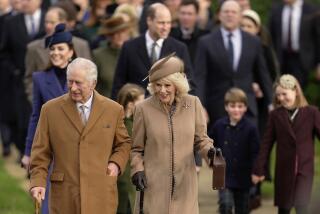Book Review : Her Majesty the Queen . . . at 60, Still ‘a Pretty Nice Girl’
- Share via
Her Majesty the Queen by Hugh Montgomery-Massingberd (Salem House: $22.95)
“Apart from her parents’ strong-minded views on the subject, there was soon something intrinsically serious, modest and tidy about the child herself.” What child was that? The one who started off as a baby with “large, dark-lashed blue eyes” and “tiny ears set close to a well-shaped head.” The one who grew up in Britain to exercise “a much more important and effective influence over affairs of state than is generally understood.” We’re talking about Her Majesty, Queen Elizabeth II, of whom a Beatle sang so movingly, “Her Majesty’s a pretty nice girl, but she doesn’t have a lot to say. Her Majesty’s a pretty nice girl, but she changes from day to day. I want to tell her that I love her a lot. . . . “
She’s 60 today, and Hugh Montgomery-Massingberd’s handsome illustrated volume commemorates that fact, as well as the triumph of a monarchy that seems permanent, unchanging, totally safe, even as the Commonwealth it rules over continues gently to unravel.
There is a way of writing about the English monarchy that is easy to recognize but hard to define. Montgomery-Massingberd has the style down pat. He solemnly reminds us, for instance, that “the Queen’s information is as good as any statesman’s and, as her reign progresses, she becomes increasingly knowledgeable. With her retentive brain, this means that her political contribution, bounded by Bagehot’s constitutional maxim about consulting, encouraging and warning, grows ever more important.”
But with no perceptible shift in tone, he also observes that “In full bloom as she approached her 31st birthday, the Queen’s magnetism when seen in the flesh quite bowled over those who had only seen her in still photographs.” What do these two sentences mean when said by the same person, about the same person? Whatever it is, Americans must have forgotten.
But this is a marvelously entertaining book, even at its most pious and most prurient. Montgomery-Massingberd gravely reminds us of that messy abdication, the King who irresponsibly gave away an empire for the woman he loved, and his wife: “In 1985, the Duchess is still hanging on to a life that has long since lost all meaning, in a pathetic state where even the petty denial of her right to the style, ‘Her Royal Highness,’ has become an irrelevance.”
We are also reminded that the Duke of Windsor gave up the crown to his brother, the Duke of York (a painful stammerer, semi-cured by specialists and his devoted wife), who became King George VI, just in time for World War II. His two daughters, Elizabeth and Margaret Rose, seem to have spent their adolescences in coveralls, changing tires on lorries for the camera.
Then the King’s death turned princess into queen. Elizabeth had already married the handsome Prince Philip, protege of Lord Mountbatten and before that, part of an “unemployed-and-uninsured” Greek royal family that had been disintegrating through Europe. Again, with his curious blend of reverence and malice, Montgomery-Massingberd quotes the prince as being fond of saying, “I am one of those ignorant bums who never went to university and a fat lot of harm it did me,” and also recording for posterity that when the prince visited Gibraltar, he “is supposed to have thrown some peanuts to photographers, affecting to mistake them for the Barbary apes capering on the Rock. This sort of behavior . . . finds the royal family at their most disobliging.”
We learn once again about Charles and Anne and Andrew and Edward. And just as we thought we really would never have Nixon to kick around any more, we read that in 1970, “Prince Charles and Princess Anne went down to stay at the White House, a visit marred by President Nixon’s clumsy attempts to encourage a friendship between the Prince and his daughter Tricia.”
This, then, is “dishing” of the most highbrow and demented variety. It’s all wonderful, whatever it means.
Only twice does stylistic seismography jar this staid volume--once, during the tale of the deranged man who broke into the palace and tried to commit suicide on the Queen’s bed (the Queen repeatedly called for help but was ignored), and again, as Montgomery-Massingberd attempts to characterize the Queen Mother: “Why should not Her Majesty . . . dress like the wedding cake E. M. Forster once claimed to have mistaken her for . . .?”
Why not indeed? And may the serious, modest and tidy reigning monarch look forward to an equally long life, and an equally pleasing old age.
More to Read
The biggest entertainment stories
Get our big stories about Hollywood, film, television, music, arts, culture and more right in your inbox as soon as they publish.
You may occasionally receive promotional content from the Los Angeles Times.










